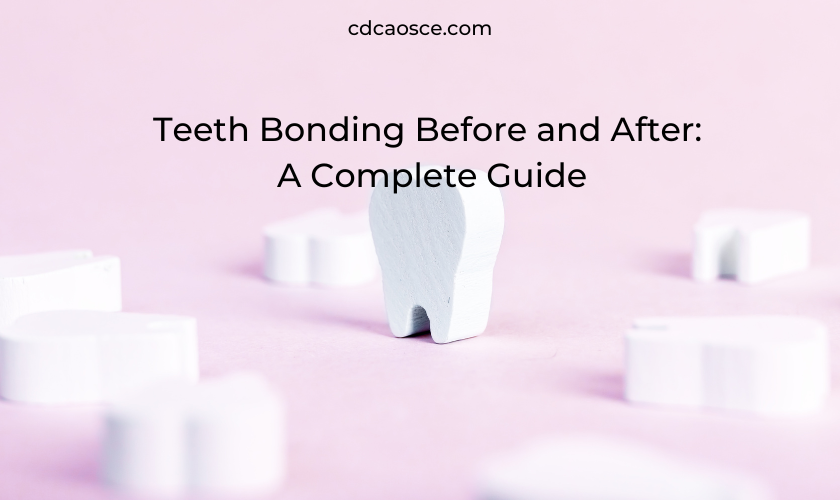Zaenkrat se Gel prihodnosti šteje za eksperimentalno. V Združenem kraljestvu je 200 prostovoljcev že ugotovilo s kršitvijo erekcije od 18 do 70 let. Program kliničnega testa je precej zabaven: viagra lekarna so dolžni redno seksati. Žal se ne poroča, da bi morali to težavo rešiti predmete deklic ali samih.
Introduction
Teeth bonding is a cosmetic dental procedure that can improve the appearance of chipped, cracked, or stained teeth. Lets discuss what you need to know about teeth bonding before and after, including the procedure, benefits, risks, and aftercare.
What is Teeth Bonding?
Teeth bonding is a cosmetic dental procedure that involves the application of a tooth-colored resin material to the surface of the teeth. The material is then sculpted and polished to blend in with the surrounding teeth, resulting in a natural-looking smile. Teeth bonding can be used to correct a variety of dental issues, such as chipped teeth, cracked teeth, stained teeth, gaps between teeth, misshapen teeth, exposed tooth roots, and decayed teeth.
The Teeth Bonding Procedure
The teeth bonding procedure is a relatively quick and painless process. Here’s what you can expect during the procedure:
- Consultation: Before the procedure, you will meet with your dentist to discuss your goals and expectations for the treatment. Your dentist will also examine your teeth to determine if teeth bonding is the right solution for your needs.
- Preparation: Your dentist will prepare your teeth by roughening the surface and applying a conditioning liquid. This helps the bonding material adhere to the teeth.
- Bonding: The bonding material is then applied to the teeth and shaped to the desired form. A special light is used to harden the material.
- Finishing touches: Once the bonding material has hardened, your dentist will trim and shape it to blend in with the surrounding teeth. The teeth are then polished for a natural-looking finish.
Benefits of Teeth Bonding
Teeth bonding offers numerous benefits, including:
- Improved appearance: Teeth bonding can improve the appearance of your smile by correcting various dental issues.
- Quick and painless: The teeth bonding procedure is a relatively quick and painless process, with most procedures taking less than an hour.
- Affordable: Teeth bonding is an affordable cosmetic dental procedure compared to other options like veneers or crowns.
- Minimally invasive: Teeth bonding is a minimally invasive procedure that preserves more of the natural tooth structure than other options.
- Versatile: Teeth bonding can be used to correct a wide range of dental issues, making it a versatile treatment option.
Risks of Teeth Bonding
While teeth bonding is generally safe, there are some risks to be aware of, including:
- Discoloration: Bonding material can become discolored over time, particularly if you consume staining foods and beverages like coffee or red wine.
- Chips and cracks: Bonding material can chip or crack, particularly if you bite down on hard objects like ice or pens.
- Sensitivity: Teeth may be sensitive to hot and cold temperatures immediately following the procedure.
- Limited lifespan: Bonding material typically lasts between 3 to 10 years, depending on factors like oral hygiene and wear and tear. After this time, the bonding material may need to be repaired or replaced.
- Not suitable for all cases: Teeth bonding may not be suitable for severe dental issues or large restorations. In these cases, other options like veneers or crowns may be more appropriate.
Teeth Bonding Before and Aftercare
Proper care of your teeth after the bonding procedure is essential to maintain their appearance and longevity. Here are some tips for teeth bonding before and aftercare:
- Avoid staining foods and beverages like coffee, tea, and red wine for at least 48 hours after the procedure.
- Brush and floss your teeth regularly to maintain good oral hygiene.
- Use a soft-bristled toothbrush to avoid damaging the bonding material.
- Avoid biting down on hard objects like ice or pens, as this can cause the bonding material to chip or crack.
- Visit your dentist regularly for check-ups and cleanings.
FAQs
Is teeth bonding painful?
No, the teeth bonding procedure is generally painless. You may experience some sensitivity to hot and cold temperatures immediately following the procedure, but this typically subsides within a few days.
How long does teeth bonding last?
Bonding material typically lasts between 3 to 10 years, depending on factors like oral hygiene and wear and tear. After this time, the bonding material may need to be repaired or replaced.
Can teeth bonding be reversed?
Yes, teeth bonding can be reversed if necessary. Your dentist can remove the bonding material and restore the tooth to its original state.
How much does teeth bonding cost?
The cost of teeth bonding varies depending on factors like the extent of the treatment, the location of the dental practice, and the experience of the dentist. On average, teeth bonding can cost between $300 to $600 per tooth.
Conclusion
Teeth bonding is a popular and effective cosmetic dental procedure that can improve the appearance of your smile. It is a quick and painless procedure that offers a variety of benefits, including affordability and versatility. While there are some risks to be aware of, proper care and maintenance can help ensure the longevity of the bonding material.



